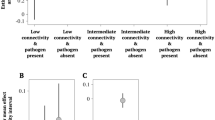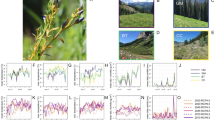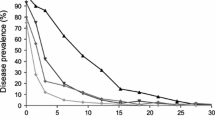Abstract
Many generalist pathogens are influenced by the spatial distributions and relative abundances of susceptible host species. The spatial structure of host populations can influence patterns of infection incidence (or disease outbreaks), and the effects of a generalist pathogen on host community dynamics in a spatially heterogeneous community may differ from predictions derived via simple models. In this paper, we model the transmission of a generalist pathogen within a patch framework that incorporates the movement of vectors between discrete host patches to investigate the effects of local host community composition and vector movement rates on disease dynamics.
We use barley and cereal yellow dwarf viruses (B/CYDV), a suite of generalist, aphid-vectored pathogens of grasses, and their interactions with a range of host species as our case study. We examine whether B/CYDV can persist locally or in a patch framework across a range of host community configurations. We then determine how pathogen-mediated interactions between perennial and annual competitors are altered at the local and regional scale when the host populations are spatially structured. We find that the spatial configuration of the patch system, host composition within patches, and patch connectivity affect not only the ability of the pathogen to invade a fragmented system, but also determine whether the pathogen facilitates the invasion of a non-native host species. Further, our results suggest that connectivity can interact with arrival time and host infection tolerance to determine the success or failure of establishment for newly arriving species.
Similar content being viewed by others
References
Allan, B., Langerhans, R., Ryberg, W., Landesman, W., Griffin, N., Katz, R., Oberle, B., Schutzenhofer, M., Smyth, K., de St. Maurice, A., Clark, L., Crooks, K., Hernandez, D., McLean, R., Ostfeld, R., Chase, J. (2009). Ecological correlates of risk and incidence of west Nile virus in the united states. Oecologia, 158(4), 699–708.
Allan, B. F., Keesing, F., & Ostfeld, R. S. (2003). Effect of forest fragmentation on Lyme disease risk. Conserv. Biol., 17(1), 267–272.
Arino, J. (2009). Diseases in metapopulations. In: Series in contemporary applied mathematics: Vol. 11, Modeling and dynamics of infectious diseases (pp. 65–123).
Arino, J., Davis, J. R., Hartley, D., Jordan, R., Miller, J. M., & van den Driessche, P. (2005). A multi-species epidemic model with spatial dynamics. Math. Med. Biol., 22(2), 129–142.
Arino, J., & van den Driessche, P. (2006). Disease spread in metapopulations. Fields Inst. Commun., 48, 1–12.
Begon, M., Bowers, R. G., Kadianakis, N., & Hodgkinson, D. E. (1992). Disease and community structure: the importance of host self-regulation in a host-host-pathogen model. Am. Nat., 139(6), 1131–1150.
Borer, E. T., Adams, V. T., Engler, G. A., Adams, A. L., Schumann, C. B., & Seabloom, E. W. (2009). Aphid fecundity and grassland invasion: invader life history is the key. Ecol. Appl., 19(5), 1187–1196.
Borer, E. T., Hosseini, P. R., Seabloom, E. W., & Dobson, A. P. (2007). Pathogen-induced reversal of native dominance in a grassland community. Proc. Natl. Acad. Sci. USA, 104(13), 5473.
Bowers, R. G., & Turner, J. (1997). Community structure and the interplay between interspecific infection and competition. J. Theor. Biol., 187(1), 95–109.
Brownstein, J. S., Skelly, D. K., Holford, T. R., & Fish, D. (2005). Forest fragmentation predicts local scale heterogeneity of Lyme disease risk. Oecologia, 146(3), 469–475.
Buskirk, J. V., & Ostfeld, R. S. (1998). Habitat heterogeneity, dispersal, and local risk of exposure to Lyme disease. Ecol. Appl., 8(2), 365–378.
Case, T. J. (1990). Invasion resistance arises in strongly interacting species-rich model competition communities. Proc. Natl. Acad. Sci. USA, 87(24), 9610.
Chase, J. M., Abrams, P. A., Grover, J. P., Diehl, S., Chesson, P., Holt, R. D., Richards, S. A., Nisbet, R. M., & Case, T. J. (2002). The interaction between predation and competition: a review and synthesis. Ecol. Lett., 5(2), 302–315.
Chitnis, N., Hyman, J. M., & Cushing, J. M. (2008). Determining important parameters in the spread of malaria through the sensitivity analysis of a mathematical model. Bull. Math. Biol., 70(5), 1272–1296.
Condeso, T. E., & Meentemeyer, R. K. (2007). Effects of landscape heterogeneity on the emerging forest disease sudden oak death. Ecology, 95, 364–375.
Cronin, J. P., Welsh, M. E., Dekkers, M. G., Abercrombie, S. T., & Mitchell, C. E. (2010). Host physiological phenotype explains pathogen reservoir potential. Ecol. Lett., 13(10), 1221–1232.
de Castro, F., & Bolker, B. (2005). Mechanisms of disease-induced extinction. Ecol. Lett., 8(1), 117–126.
Dobson, A. (2004). Population dynamics of pathogens with multiple host species. Am. Nat., 164, S65–S78 (supplement).
Fabre, F., Pierre, J. S., Dedryver, C. A., & Plantegenest, M. (2006). Barley yellow dwarf disease risk assessment based on Bayesian modelling of aphid population dynamics. Ecol. Model., 193(3–4), 457–466.
Grenfell, B., & Harwood, J. (1997). (Meta) population dynamics of infectious diseases. Trends Ecol. Evol., 12(10), 395–399.
Hanski, I. (1998). Metapopulation dynamics. Nature, 396(6706), 41–49.
Hatcher, M. J., Dick, J. T. A., & Dunn, A. M. (2006). How parasites affect interactions between competitors and predators. Ecol. Lett., 9(11), 1253–1271.
Hess, G. (1996). Disease in metapopulation models: implications for conservation. Ecology, 77(5), 1617–1632.
Hess, G. R. (1994). Conservation corridors and contagious disease: a cautionary note. Conserv. Biol., 8(1), 256–262.
Hess, G. R., Randolph, S. E., Arneberg, P., Chemini, C., Furlanello, C., Harwood, J., Roberts, M. G., & Swinton, J. (2002). Spatial aspects of disease dynamics. In The ecology of wildlife diseases (pp. 102–118). Oxford: Oxford University Press.
Holmes, E. E. (1997). Basic epidemiological concepts in a spatial context. In Spatial ecology: the role of space in population dynamics and interspecific interactions (pp. 111–136).
Holt, R. D., Dobson, A. P., Begon, M., Bowers, R. G., & Schauber, E. (2003). Parasite establishment and persistence in multi-host-species systems. Ecol. Lett., 6, 837–842.
Holt, R. D., & Dobson, A. P. (2006). Disease ecology: community structure and pathogen dynamics. In Extending the principles of community ecology to address the epidemiology of host-pathogen systems.
Holt, R. D., & Pickering, J. (1985). Infectious disease and species coexistence: a model of Lotka-Volterra form. Am. Nat., 126(2), 196–211.
Irwin, M. E., & Thresh, J. M. (1990). Epidemiology of barley yellow dwarf: a study in ecological complexity. Annu. Rev. Phytopathol., 28(1), 393–424.
Irwin, M. E., Thresh, J. M., & Harrison, B. D. (1988). Long-range aerial dispersal of cereal aphids as virus vectors in North America (and Discussion). Philos. Trans. R. Soc. Lond. B, Biol. Sci., 321(1207), 421–446.
Jeger, M. J., Pautasso, M., Holdenrieder, O., & Shaw, M. W. (2007). Modelling disease spread and control in networks: implications for plant sciences. New Phytol., 174(2), 279–297.
Keeling, M. J., Bjornstad, O. N., & Grenfell, B. T. (2004). Metapopulation dynamics of infectious diseases. In Ecology, evolution and genetics of metapopulations (pp. 415–446). Amsterdam: Elsevier.
Keeling, M. J., Woolhouse, M. E. J., Shaw, D. J., Matthews, L., Chase-Topping, M., Haydon, D. T., Cornell, S. J., Kappey, J., Wilesmith, J., & Grenfell, B. T. (2001). Dynamics of the 2001 UK foot and mouth epidemic: stochastic dispersal in a heterogeneous landscape. Science, 294(5543), 813.
Keesing, F., Holt, R. D., & Ostfeld, R. S. (2006). Effects of species diversity on disease risk. Ecol. Lett., 9(4), 485–498.
Kendall, D. A., Brain, P., & Chinn, N. E. (1992). A simulation model of the epidemiology of barley yellow dwarf virus in winter sown cereals and its application to forecasting. J. Appl. Ecol., 29(2), 414–426.
Knops, J. M. H., Tilman, D., Haddad, N. M., Naeem, S., Mitchell, C. E., Haarstad, J., Ritchie, M. E., Howe, K. M., Reich, P. B., Siemann, E., et al. (1999). Effects of plant species richness on invasion dynamics, disease outbreaks, insect abundances and diversity. Ecol. Lett., 2(5), 286–293.
Langlois, J. P., Fahrig, L., Merriam, G., & Artsob, H. (2001). Landscape structure influences continental distribution of hantavirus in deer mice. Landsc. Ecol., 16(3), 255–266.
Leclercq-Le Quillec, F., Plantegenest, M., Riault, G., & Dedryver, C. A. (2000). Analyzing and modeling temporal disease progress of barley yellow dwarf virus serotypes in barley fields. Phytopathology, 90(8), 860–866.
Lowry, E. (2007). The role of aphid host preference in barley yellow dwarf virus epidemiology.
Malmstrom, C. M. (1998). Barley yellow dwarf virus in native California grasses. Grasslands, 8(1), 6–10.
Malmstrom, C. M., Hughes, C. C., Newton, L. A., & Stoner, C. J. (2005a). Virus infection in remnant native bunchgrasses from invaded California grasslands. New Phytol., 168(1), 217–230.
Malmstrom, C. M., McCullough, A. J., Johnson, H. A., Newton, L. A., & Borer, E. T. (2005b). Invasive annual grasses indirectly increase virus incidence in California native perennial bunchgrasses. Oecologia, 145(1), 153–164.
McCallum, H., & Dobson, A. (2002). Disease, habitat fragmentation and conservation. Proc., Biol. Sci., 269(1504), 2041–2049.
McCormack, R. K. (2006). Multi-host multi-patch mathematical epidemic models for disease emergence with applications to hantavirus in wild rodents. PhD thesis, Texas Tech University.
McCormack, R. K., & Allen, L. J. S. (2007). Disease emergence in multi-host epidemic models. Math. Med. Biol., 24(1), 17.
McElhany, P., Real, L. A., & Power, A. G. (1995). Vector preference and disease dynamics: a study of barley yellow dwarf virus. Ecology, 76(2), 444–457.
Meentemeyer, R. K., Rank, N. E., Anacker, B. L., Rizzo, D. M., & Cushman, J. H. (2008). Influence of land-cover change on the spread of an invasive forest pathogen. Ecol. Appl., 18(1), 159–171.
Mitchell, C. E., Tilman, D., & Groth, J. V. (2002). Effects of grassland plant species diversity, abundance, and composition on foliar fungal disease. Ecology, 83(6), 1713–1726.
Ostfeld, R., Keesing, F., & Eviner, V. T. (2008). Infectious disease ecology: the effects of ecosystems on disease and of disease on ecosystems. Princeton: Princeton University Press.
Ostfeld, R. S., Glass, G. E., & Keesing, F. (2005). Spatial epidemiology: an emerging (or re-emerging) discipline. Trends Ecol. Evol., 20(6), 328–336.
Plantegenest, M., Le May, C., & Fabre, F. (2007). Landscape epidemiology of plant diseases. J. R. Soc. Interface, 4(16), 963.
Power, A. G., & Mitchell, C. E. (2004). Pathogen spillover in disease epidemics. Am. Nat., 164, S79–S89 (supplement).
Rushton, S. P., Lurz, P. W. W., Gurnell, J., & Fuller, R. (2000). Modelling the spatial dynamics of parapoxvirus disease in red and grey squirrels: a possible cause of the decline in the red squirrel in the UK? J. Appl. Ecol. (pp. 997–1012).
Saltelli, A., Chan, K., Scott, E. M. et al. (2004). Sensitivity analysis. New York: Wiley.
Saramäki, J., & Kaski, K. (2005). Modelling development of epidemics with dynamic small-world networks. J. Theor. Biol., 234(3), 413–421.
Seabloom, E. W., Harpole, W. S., Reichman, O. J., & Tilman, D. (2003). Invasion, competitive dominance, and resource use by exotic and native California grassland species. Proc. Natl. Acad. Sci. USA, 100(23), 13384.
Seabloom, E. W., Hosseini, P. R., Power, A. G., & Borer, E. T. (2009). Diversity and composition of viral communities: coinfection of barley and cereal yellow dwarf viruses in California Grasslands. Am. Nat., 173, E79–E98.
Smith, D. L., Lucey, B., Waller, L. A., Childs, J. E., & Real, L. A. (2002). Predicting the spatial dynamics of rabies epidemics on heterogeneous landscapes. Proc. Natl. Acad. Sci. USA, 99(6), 3668–3672.
Tompkins, D. M., White, A. R., & Boots, M. (2003). Ecological replacement of native red squirrels by invasive greys driven by disease. Ecol. Lett., 6(3), 189–196.
van den Driessche, P., & Watmough, J. (2002). Reproduction numbers and sub-threshold endemic equilibria for compartmental models of disease transmission. Math. Biosci., 180(1), 29–48.
Zhang, X. S., & Holt, J. (2001). Mathematical models of cross protection in the epidemiology of plant-virus diseases. Phytopathology, 91(10), 924–934.
Author information
Authors and Affiliations
Corresponding author
Rights and permissions
About this article
Cite this article
Moore, S.M., Manore, C.A., Bokil, V.A. et al. Spatiotemporal Model of Barley and Cereal Yellow Dwarf Virus Transmission Dynamics with Seasonality and Plant Competition. Bull Math Biol 73, 2707–2730 (2011). https://doi.org/10.1007/s11538-011-9654-4
Received:
Accepted:
Published:
Issue Date:
DOI: https://doi.org/10.1007/s11538-011-9654-4




